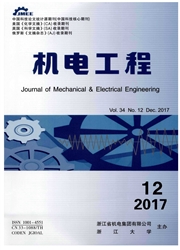

 中文摘要:
中文摘要:
针对橡胶减振元件疲劳寿命试验时间较长的问题,采用计算机仿真开展了加速寿命试验研究。利用CATIA和ABAQUS软件分别建立了橡胶减振元件的三维实体及有限元模型,采用二参数的Mooney—Rivilin模型模拟橡胶材料。通过模态分析,结合橡胶减振元件的工作状态,确定了试验系统的极限加载频率。施加3种不同的随时间变化的位移载荷,对橡胶减振元件进行了瞬态动力学分析,获得了其应力分布,从而确定了易于发生疲劳破坏的危险部位。提取橡胶减振元件危险部位的应变值,利用Manson—Coffin关系,根据橡胶材料的应变幅一疲劳寿命关系曲线,确定了3种加载条件下橡胶减振元件的破坏周期。研究结果表明,在同样的累积损伤、疲劳破坏模型条件下,通过合理提高加载频率和加载等级,可以大大缩短橡胶减振元件的疲劳寿命试验周期。
 英文摘要:
英文摘要:
Aiming at reducing the test period of rubber damping element, the simulation on the accelerated life test of rubber vibration damper was carried out. The 3D solid and finite element model were established by the use of CATIA and ABAQUS software, adopting the bi-parameter Mooney-Rivilin model as rubber material. The loading frequency boundary of the accelerated life test was obtained by the modal analysis of rubber damping element in working state. Then stress distribution of rubber damping element under three different time-variant displacement loads was obtained by the transient dynamics analysis and consequently the position fatigue damage tends to occur was identified. Finally the damage periods in three cases were determined respectively based on the strain-life curve using Manson-Coffin. The results indicate that the test period can be shortened effectively by virtue of reasonably higher loading frequency and level with the same damage model.
 同期刊论文项目
同期刊论文项目
 同项目期刊论文
同项目期刊论文
 Vibration analyses of symmetrically laminated composite cylindrical shells with arbitrary boundaries
Vibration analyses of symmetrically laminated composite cylindrical shells with arbitrary boundaries 期刊信息
期刊信息
